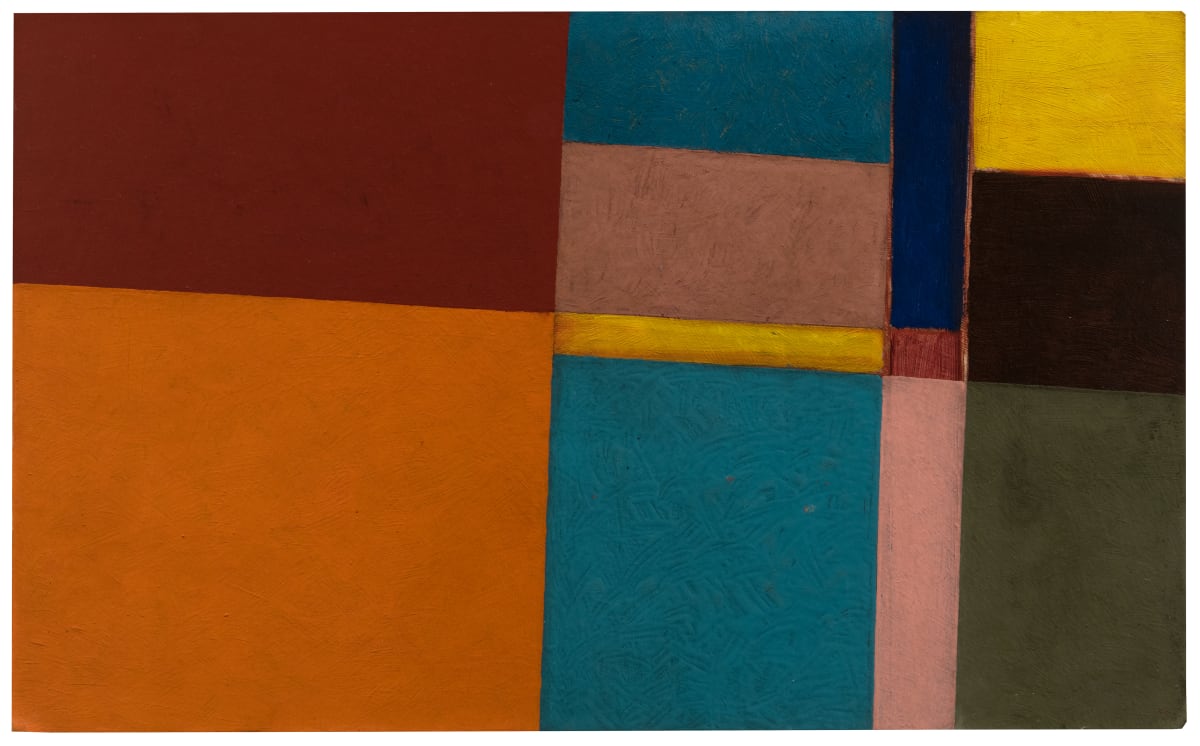
Newell described what he was trying to achieve in his work as “compression”: compressing long passages of time and experience into a single object.
A visionary artist who was an original member of the early Abstract Expressionist movement, frequenting the Cedar Tavern and the Eighth Street artist club, Roy Newell (1914-2006) was largely undiscovered in his lifetime––he created only about fifty paintings in total––but was highly regarded among artists of his generation. A close friend of Willem de Kooning and Franz Kline, Newell initially created large gestural paintings like his peers but after a series of successful exhibitions in the mid-1950s, he curiously withdrew from public view and considerably scaled down the size of his paintings. These hermetic paintings, which averaged around 12 inches on a side, were often small enough that Newell was able to hold them in his hand and use his brush with exacting precision. Newell’s mature work from the 1960s, such as this painting, resonates with a philosophical strain in American art as represented by the work of Ad Reinhardt, Alfred Jensen, and Agnes Martin that sought to prioritize geometric universality over individual psychological expression. It was only Newell, however, who maintained the skewed angle of forms as a fundamental feature of his grid compositions.
Though Newell looked to European masters such as Cezanne, Puvis de Chavannes, and Malevich, the biggest influence on Newell’s work was Albert Pinkham Ryder. Both were fascinated by the sea and boats, but Newell self-identified with Ryder on the grounds of their similar obsessive working habits. Ryder often worked on paintings for ten years or more, building up extremely impastoed layers of paint and resin. Indeed, one of the most distinctive features of Newell’s art is his compulsion to paint over works, reworking the same surfaces repeatedly for decades, to the point of sculptural encrustation. Newell described what he was trying to achieve in his work as “compression”: compressing long passages of time and experience into a single object. (1) In a fascinating coincidence, Newell discovered that his studio was the very studio that Ryder had worked and lived in decades prior, on west 15th street in New York City.
Newell’s color schemes find parallels in the works of abstractionists such as Hans Hofmann, but upon his self-imposed isolation in the mid-1950s, Newell created paintings completely on his own terms, slowly and deliberately, maintaining them “in a kind of perpetual present,” as Roberta Smith wrote in a review for the New York Times. (2) Newell, whose life was consecrated to artistic creation, was never in a hurry, revisiting and reworking the same group of some fifty paintings for five decades. His works, including this painting, represent one of the “most extreme examples of sustained attention in the history of postwar painting.” (3) As Newell once told a fellow artist, “I can feel it when I’m getting near the truth of a painting.” (4) His works are held in the collections of the Guggenheim Museum, New York; the New York University Art Collection; the Willem de Kooning Estate; the Elaine de Kooning Trust; the Pollock-Krasner House; among others.
1. Robert E. Harrist, Jr., “Color and Time: Paintings by Roy Newell,” in Color and Time: Paintings by Roy Newell 1956-2000 (New York: Steinberg Museum of Art and Pollock-Krasner House and Study Center), 13.
2. Roberta Smith, “Roy Newell: The Private Myth,” The New York Times, February 11, 2010.
3. Richard Dupont, “Roy Newell: A Recollection,” in Color and Time: Paintings by Roy Newell 1956-2000 (New York: Steinberg Museum of Art and Pollock-Krasner House and Study Center), 34.
4. Newell made this statement to Edvard Lieber on June 27, 1988. Telephone interview with Edvard Lieber by Robert E. Harrist, Jr, February 7, 2014. Harrist, “Color and Time: Paintings by Roy Newell,” in Color and Time: Paintings by Roy Newell 1956-2000 (New York: Steinberg Museum of Art and Pollock-Krasner House and Study Center), 28.
Works
News





















![Roy Newell, Untitled [double-sided], circa late 1940s / early 1950s](https://artlogic-res.cloudinary.com/w_800,c_limit,f_auto,fl_lossy,q_auto/artlogicstorage/htg1979/images/view/7c10e606cdb55dd69a67149ffa2d1a56j/hollistaggart-roy-newell-untitled-double-sided-circa-late-1940s-early-1950s.jpg)
![Roy Newell, Untitled [double-sided], circa late 1940s / early 1950s](https://artlogic-res.cloudinary.com/w_800,c_limit,f_auto,fl_lossy,q_auto/artlogicstorage/htg1979/images/view/75fee3f8679f5150a960ca1c0c0a9604j/hollistaggart-roy-newell-untitled-double-sided-circa-late-1940s-early-1950s.jpg)











